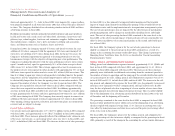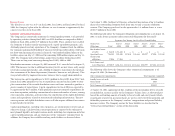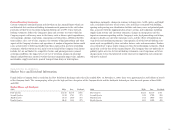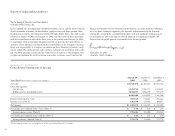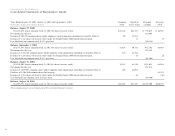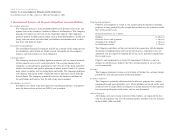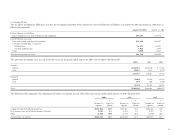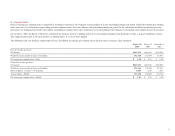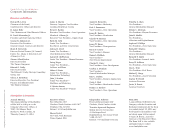Family Dollar 2003 Annual Report Download - page 28
Download and view the complete annual report
Please find page 28 of the 2003 Family Dollar annual report below. You can navigate through the pages in the report by either clicking on the pages listed below, or by using the keyword search tool below to find specific information within the annual report.
24
Family Dollar Stores, Inc. and Subsidiaries
Notes to Consolidated Financial Statements
Ye ars Ended August 30, 2003, August 31, 2002 and September 1, 2001
1. Description of Business and Summary of Significant Accounting Policies:
Description of business:
The Company operates a chain of neighborhood retail discount stores in 43 con-
tiguous states in the Northeast, Southeast, Midwest and Southwest. The Company
manages its business on the basis of one reportable segment. The Company’s
products include hardlines merchandise such as household products, health and
beauty aids and snack and other food, and softlines merchandise such as cloth-
ing, shoes and domestic items.
Principles of consolidation:
The consolidated financial statements include the accounts of the Company and
its subsidiaries, all of which are wholly-owned. All significant intercompany
balances and transactions have been eliminated.
Cash equivalents:
The Company considers all highly liquid investments with an original maturity
of three months or less to be cash equivalents. The carrying amount of the
Company’s cash equivalents approximates fair value due to the short maturities
of these investments and consists primarily of money market funds, U.S. govern-
ment agency securities and tax-exempt notes and bonds. The Company maintains
cash deposits with major banks which from time to time may exceed federally
insured limits. The Company periodically assesses the financial condition of
the institutions and believes that the risk of any loss is minimal.
Merchandise inventories:
Inventories are valued using retail prices less markon percentages, and approxi-
mate the lower of first-in, first-out (FIFO) cost or market.
Property and equipment:
Property and equipment is stated at cost. Depreciation for financial reporting
purposes is being provided by the straight-line method over the estimated useful
lives of the related assets.
Estimated useful lives are as follows:
Buildings 33–40 years
Furniture, fixtures and equipment 3–10 years
Transportation equipment 3–10 years
Leasehold improvements 5–10 years
The Company capitalizes certain costs incurred in connection with developing,
obtaining and implementing software for internal use. Capitalized costs are
amortized over the expected economic life of the assets, generally ranging from
five to eight years.
Property and equipment is reviewed for impairment whenever events or
changes in circumstances indicate that the carrying amount of an asset may
not be recoverable.
Revenues:
The Company recognizes revenue, net of returns, at the time the customer tenders
payment for and takes possession of the merchandise.
Insurance liabilities:
The Company is primarily self-insured for health care, property loss, workers’
compensation and general liability costs. These liabilities are based on the total
estimated costs of claims filed and estimates of claims incurred but not reported,
less amounts paid against such claims, and are not discounted.
Advertising costs:
Advertising costs, net of co-op recoveries from vendors, are expensed the first
time the advertising is run. Net advertising expense amounts were not material
in fiscal 2003, 2002 and 2001.




